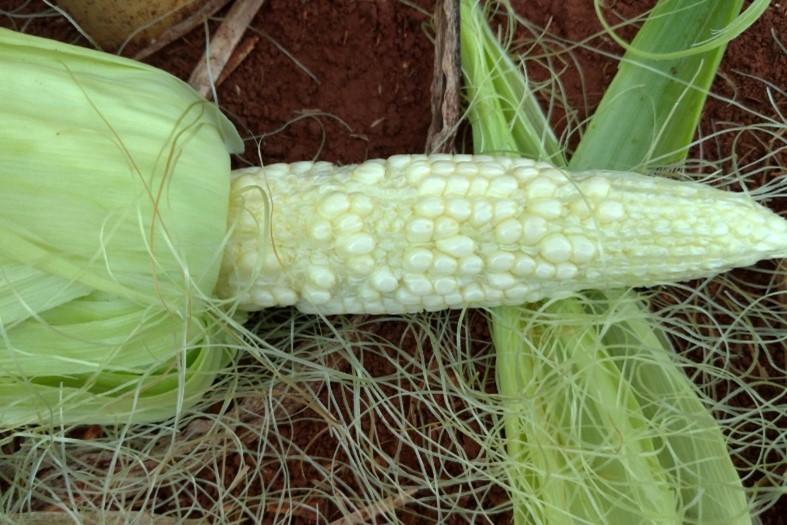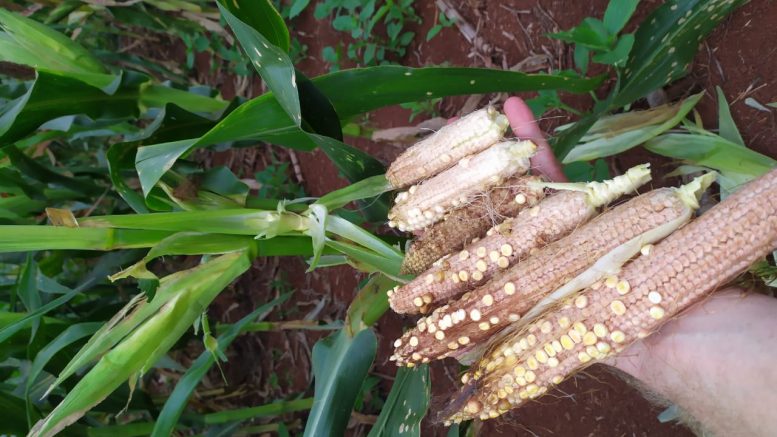“A cigarrinha-do-milho (Dalbulus maidis) é uma preocupação generalizada em todas as regiões produtoras de milho no Brasil…”
Michele Regina Lopes da Silva é pesquisadora da área de proteção de plantas no Instituto de Desenvolvimento Rural do Paraná – IDR-Paraná, colaboradora do Programa de Pós-Graduação em Agronomia da UEL/IDR-Paraná.
Lopes da Silva é graduada em ciências biológicas, especialista em biologia aplicada à saúde, mestre em microbiologia e doutora em agronomia pela UEL.

Michele Regina, pesquisadora no IDR-Paraná
AgriBrasilis – O problema da cigarrinha-do-milho está se agravando no Brasil?
Michele Lopes da Silva – A cigarrinha-do-milho (Dalbulus maidis) é nativa de regiões tropicais, e motivo de preocupação generalizada em todas as regiões produtoras no Brasil. Esse inseto, além de sugar nutrientes das plantas, excreta substância açucarada que atrai outros insetos e favorece o crescimento de fumagina [fungo de cor escura], prejudicando a fotossíntese. Ao se alimentar, pode transmitir patógenos responsáveis pelo Complexo de Enfezamento do Milho (CEM).
A cigarrinha africana Leptodelphax maculigera foi reportada no Brasil em 2022, em Goiás, e já está presente nos estados do sul do país. Esse inseto é um potencial vetor de doenças do CEM, pois embora ainda sejam necessários estudos de comprovação da transmissão, patógenos do complexo já foram detectados geneticamente em L. maculigera. Diferente de D. maidis, essa cigarrinha se alimenta de diversas plantas gramíneas e leguminosas, o que teoricamente pode diminuir a transmissão dos patógenos ao milho.
“A ausência de “pontes verdes” e a sincronização de pulverizações resultariam no melhor controle das populações das cigarrinhas”
AgriBrasilis – Como é realizado o monitoramento e controle dessa praga?
Michele Lopes da Silva – Não há controle curativo para doenças do CEM, ou seja, é preciso focar na prevenção por meio do manejo integrado. Ações pontuais, como somente a aplicação de inseticidas, mostraram-se ineficientes nas safras anteriores.
A base do manejo é a escolha de sementes de híbridos tolerantes, geralmente de origem genética tropical, que devem receber tratamento de sementes antes da semeadura. Em seguida, cerca de uma semana após a emergência da planta, deve ser realizada pulverização de “choque”, com inseticida químico, visando matar insetos contaminados que estão chegando na lavoura. A próxima aplicação deve ser de inseticida biológico, para atingir insetos que não morreram na primeira pulverização e preservar inimigos naturais da cigarrinha e de outras pragas do milho. Produtores têm relatado que o melhor horário de aplicação desse tipo de inseticida é durante a noite.
Pulverizações devem ser alternadas com diferentes princípios ativos químicos e entre químicos e biológicos, até que a planta atinja o estádio V8, com cerca de 40 dias. Depois disso, pulverizações só devem ser realizadas se for observada população muito alta de cigarrinhas e ocorrência de escurecimento nas folhas, causado pela fumagina.
O período crítico de proteção da planta de milho é da emergência até o estágio V8 e quanto mais nova a planta for contaminada, maiores serão as perdas observadas na fase reprodutiva. Após o estádio V8, cigarrinhas continuam a ser observadas nas lavouras, mas tendem a migrar para outras lavouras, em busca de plantas mais novas para alimentação e reprodução.
É necessária a realização de uma boa colheita, visando não perpetuar patógenos e cigarrinhas no campo. A colheita bem feita evita plantas de milho espontâneas [tigueras], que são reservatórios de patógenos e insetos.
Outra coisa importante é respeitar as janelas de semeadura das regiões, pois lavouras em diferentes estágios de desenvolvimento geram “pontes verdes” que também servem de reservatório dos patógenos e das cigarrinhas.
O manejo ideal seria através da união dos produtores vizinhos, que compõem uma microbacia. Os produtores deveriam sincronizar suas ações para diminuir as perdas com o CEM. A ausência de “pontes verdes” e a sincronização de pulverizações resultariam no melhor controle das populações das cigarrinhas.
O monitoramento tem sido realizado com uso de armadilhas adesivas e/ou luminosas. Os dados de número de cigarrinhas capturadas e a sua infectividade com patógenos do CEM compõem os boletins e alertas.
Custos de manejo variam de acordo com os produtos, mas o investimento em híbridos menos suscetíveis às doenças e em inseticidas biológicos é vantajoso para as culturas em sucessão. Embora o custo com inseticidas biológicos possa ser um pouco maior, eles representam um investimento para as próximas culturas em sucessão.
Temos indicado o reforço no tratamento de sementes e 4 – 5 aplicações de inseticidas, de acordo com a população do inseto. Aplicação de inseticidas biológicos após o estádio V8 pode auxiliar na diminuição da população de cigarrinhas infectadas, que migram para outras lavouras.

FONTE: IDR-Paraná
AgriBrasilis – Que doenças são transmitidas por esse inseto, e quais são os danos e prejuízos causados?
Michele Lopes da Silva – O CEM é composto por doenças sistêmicas, que afetam a fisiologia, a nutrição, o desenvolvimento, e a produção da planta.
A cigarrinha transmite as bactérias ‘Candidatus Phytoplasma asteris’ (Enfezamento pálido-Corn stunt spiroplasma), Spiroplasma kunkelii (Enfezamento vermelho-Maize bushy stunt phytoplasma) e os vírus Maize Rayado Fino Virus-MRFV (Risca do milho) e Maize Striate Mosaic Virus-MSMV (Mosaico estriado do milho).
Prejuízos podem apenas ser estimados, porque fatores ambientais como geadas e estiagens ocorrem simultaneamente ao CEM. Assim, não é possível associar as perdas somente às doenças transmitidas pela cigarrinha. Os percentuais de perdas são reportados por lavouras individuais, e podemos citar perdas de 40 até 100% da produção.
A ocorrência de doenças que causam podridões no colmo pode agravar efeitos do enfezamento. Essas podem causar quebras no colmo e o tombamento de plantas, mesmo no caso das menos sintomáticas.
AgriBrasilis – Quais são os sintomas da infestação por cigarrinha nas lavouras?
Michele Lopes da Silva – Os sintomas da doença variam de acordo com a fase fenológica em que a planta foi infectada e o grau de resistência da variedade ou híbrido. Há plantas que não apresentam muitos sintomas, mas apresentam decaimento na produção. As plantas também podem apresentar infecção múltipla dos patógenos, o que dificulta o diagnóstico.
Geralmente, a planta fica inteiramente depauperada, pois ao se alimentar a cigarrinha deposita patógenos no floema, o que facilita a dispersão dos patógenos e o entupimento dos vasos, restringindo a circulação dos nutrientes.
No colmo ocorre o encurtamento dos internódios, levando à diminuição do tamanho da planta. Folhas infectadas com molicutes apresentam amarelecimento ou avermelhamento que se inicia no ápice foliar e espalha-se por toda a folha, seguido de ressecamento começando pelas bordas. Também pode ocorrer perfilhamento nas axilas foliares. Pode haver quebramento ou tombamento da planta.
Em folhas infectadas pelo vírus MRFV, iniciam-se pequenos pontos cloróticos na base e ao longo das nervuras de folhas jovens que coalescem formando riscas cloróticas. Danos causadas pelo vírus MSMV iniciam com lesões mosqueadas na base das folhas, que evoluem para listras ou estrias cloróticas. Espigas apresentam redução tamanho, grãos pequenos, manchados, frouxos e “chochos”. Também pode ocorrer multiespigamento sem enchimento de grãos. É comum também o apodrecimento de espigas.

FONTE: IDR-Paraná
AgriBrasilis – Onde tem sido relatadas as maiores perdas por conta da cigarrinha?
Michele Lopes da Silva – Anteriormente, os problemas com enfezamento do milho eram relatados nas regiões Norte, Nordeste e Centro-Oeste do Brasil. Agora são relatadas perdas em todas as regiões produtoras de milho e a cada ano os focos ocorrem em diferentes locais, provavelmente devido às alterações nas condições ambientais e de manejo, que influenciam as populações de cigarrinhas.
Anualmente são relatadas perdas maiores em todas as regiões produtoras de milho no país. A cigarrinha está bem adaptada, e as alterações ambientais e ausência de manejo correto têm favorecido as populações de insetos.
LEIA MAIS:

